Eel, pie and mash houses are bits of living history and are very much a London invention. The houses were a Victorian creation, though sellers had had stalls since the eighteenth century. Eels were very cheap and just swimming about in the River Thames. Strangley, they took off during a time when the heavily-polluted Thames did not have any eels swimming in its waters. The eels did arrive on the Thames though; brought up on barges from Holland. These days they come from Ireland.
There are three elements to the classic meal: pie, mash and eel liquor. The pies began life as eel pies, but over time the pies were made with minced beef and onion; mashed potatoes speak for themselves; and the liquor is the special part. It is made from an eel gravy and is heavily flavoured parsley sauce. You must put on liberal amounts of salt, vinegar and pepper or chili on there too. They also sell stewed eels as well as the other London classic, jellied eels. You can also buy live eels to take home and cook for yourself, if you are so inclined.
They are impressive inside, they’re not ostentatious or anything like that, but being Victorian buildings they have the beautifully-tiled walls that we associate with the Victorians’ eating establishments, public houses and urinals!
I was in London over Christmas so I decided, upon my visit, I would find one and try its wares. There are three families that own the best shops: the Cookes, Manzes and the Kellys I went to F. Cooke’s in Hackney, the first to have a pie and mash house. Frederick Cooke opened his first shop in Clerkenwell in 1862 selling the “poor-man’s delicacy”.
One of his daughters married a Manze, who were an Italian family selling ice cream, and they opened some pie and mash houses too. Their own grandson now runs their first shop on Tower Bridge. The Kellys were an Irish family that arrived relatively late to the trade but are considered the best. At the peak of business, two tons of live eels were consumed per shop! Now there are around 25, so I wanted to go to one before they disappeared.
Walking into F. Cookes really felt like walking into the past. The place hasn’t changed at all for decades and is now a listed building. I ordered hot stewed eels with mash and liquor and a cup of tea. I sat down to eat them with a liberal seasoning with salt, pepper and vinegar. I like eels, so I knew I would like the food.
Eels have quite a delicate flavour, so they went very well with the bland potatoes and liquor; a great winter-warmer. I also ordered some jellied eels – cooked eels set in an aspic jelly made from eel bones. They are an acquired taste, apparently. The eels themselves were good but eating them cold with the jelly was not the gastronomic treat I was expecting. Hey-ho, you win some, you lose some.
If you like the blogs and podcast I produce, please consider treating me to a virtual coffee or pint, or even a £3 monthly subscription: follow this link for more information.
The eel, pie and mash shops are under threat today, and it is not just because of the changing tastes of we Britons, it is because the European eel is becoming threatened. Long gone are the days when people set eel traps on the mudflats of the Thames, or anywhere else, because since 1980, the numbers of eel dropped by 95 per cent. No one really knows why the eel population has crashed by this huge amount, but overfishing, pollution and changes in the ocean current brought on by climate change are the most cited potential causes. I imagine that the latter reason is the most important; eels are catadromous fish, which means that they live in freshwater, but swim to the ocean to spawn (the opposite being anadromous fish, like salmon). The European eel (Anguilla anguilla) swims all the way to the Sargasso Sea near Bermuda. The eel fry – called leptocephali – take three years to swim across the ocean, until they reach an estuary.
They look nothing like an eel, and for a long time considered totally different species. At the estuary, they metamorphose into elvers, or glass eels, miniature transparent versions of the adult. You can set your clock by the elvers’ migration up the rivers, and people used to collect huge amounts of them, usually in pillowcases, to feed their families.
This no longer happens; places where they used to swarm no contain hardly any. There are only a few people that fish for them, and they hold their fishing spots shrouded in secrecy because they now go for over £500 per pound! I have a soft-spot for elvers and eels – my very first scientific publication was on elvers in Mull, Scotland.
It might not be over for the eel though: a huge amount of migrating elvers were spotted swimming up the River Severn in 2010, say the BBC (see here). Hopefully this isn’t just a freak occurrence.


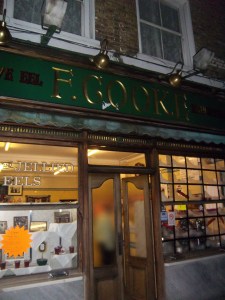
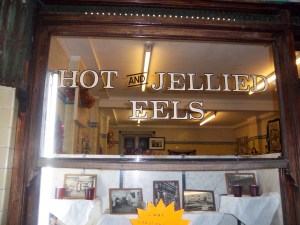
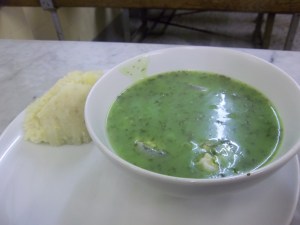

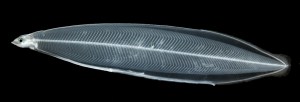
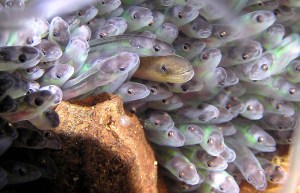

I’m pleased to say we saw more eels in the stream outside our County Dublin gate last year than we have seen in many years. We used to set an eel trap occasionally in a nearby river but haven’t done so since the population collapse – it just doesn’t seem responsible. In my childhood my grandad used to set traps in a local fenland dyke – alas these habitats have long since been completely drained. Simply skinning and frying in butter are my favourite way to eat them – though it takes strong nerves since the effect of heat on the muscles is to make them twist as though they are still alive.
I was interested in the photograph of jellied eels in the post. The proportionm of jelly to eel and the clarity of the jelly both worried me a little in terms of flavour and texture. On my occasional forays into Birmingham market I try and stop off for a snack at the seafood stall there. The jellied eels there are delicious but the jelly is less firm than that shown in the picture – dense, slightly cloudy and just on the edge of liquid. And less jelly and more eel. The word unctuous comes to mind. I’ve never made it to one of the pie shops – I don’t get to London more than once in about ten years. Must try and make it on my next visit. St Johns was the main event last time.
I find myself wondering what contribution the price of elvers in Japan made to population collapse?
LikeLike
Hi Kathryn. I have to say I have been guilty of eating wild eel in recent years. I couldn’t do elvers though – I’d feel far too guilty. It is true that you need a strong never to hill them. I did it once and found it rather stressful – they just don’t stop moving. i didn’t know they writhed even when dead. I was going to do a separate post on it as well as giving a recipe or two; I try to keep each post under 900 words.
I am not sure if overfishing of elvers is actually to blame – there’s no strong evidence to suggest it is, but it can’t have helped. I was surprised to see that the Japanese farm eels now, which I imagined impossible.
LikeLike
They are farmed using wild elvers as far as I know – that’s what they do with the Irish ones you ate in London
I’m occasionally guilty of eating the wild ones – especially smoked or, as I mentioned, from that stall in Birmingham market. Occasionally greed overcomes ethics.
LikeLike
Indeed you are right – I know I shouldn’t eat many things for ethical reasons. Maybe the guilt makes them taste nicer..?
LikeLike
Had pies and ells a couple of days ago on the Roman Road. what a joy
mike battcock
LikeLike
It is good. However these days I am in two minds as to whether I should be eating eel or not. I’ll be writing a postg on it soon….
LikeLike
Where did you come across that photo of the eels all crowded together on a rock? I’d like to use it for a publication and would like to give due credit to the photographer. Could you please contact me?
LikeLike
I didn’t take it unfortunately. I think I just found it on google image search for elvers or glass eels. It may be from the BBC. It was naughty of me to not source it!
LikeLike
I was brought up on pie and mash,used to go with my gran to the chapel st market Islington then when I started work was my Friday lunch at the Hoxton pie and mash would love a good recipe as I now live in Australia and they don’t have it here worse luck
LikeLike
Is it easy to buy eels over there in Oz? You should start a trend!
LikeLike
If you’re in Oz you can import them to the mainland from Tasmania or even from New Zealand. I’d always add gelatine to the cooling broth to make the jelly set firm. Good tucker!
LikeLike
Born and raised in Bethnal Green,I now live in NZ and have made up my own recipe. Just boil the mince in salted water. Cook potatoes and mash with no milk or butter. Make the liquor by boiling eel ( we have bought conger eel from the supermarket- lots of bones but tastes good)and saving the stock (I usually find that the stock is too fishy so you can water it down) I then boil parsley in the eel stock and thicken with flour and add a bit of salt and pepper. I make the pastry similar to hot water pastry. I use a little oil and a little warm to hot water and then add plain flour and a bit of salt until a pastry. I roll it out and cook separately i.e don’t make an actual pie- I just find this better for some reason. Then dish it all up -mince, mash, pie top and cover with the liquor. Lovely. Add salt and vinegar.Not quite authentic but very acceptable when you live on the other side of the earth.
LikeLike
That all sounds pretty good to me. Does the conger eel resemble freshwater eel in any way though (congers are not true eels and are quite distantly related)?
LikeLike
Don’t know- I just saw it in the supermarket and thought- what do you do with eel? I know!! ( Because we used to get hot eels and liquor at the pie shop, Kelly’s in Roman Road .The one closest to St Stephens Rd if you ever get there.) ( Jealous if you do) So we bought some and took it home and boiled it to death- which produced a great stock – which I water down because it is a bit too strong for making liquor- you don’t want to over power it- but we removed the bones (lots) and had the eel meat in some liquor with mash- great. I also just did the same thing a few weeks later but kept the stock frozen and de boned the fish (lots of bones) and froze too. I used that in a fish pie with some salmon. So still had the stock for a later date.
Pie and mash was a great part of my childhood and my sister who lives just out of Toronto, when she went back to the UK on holiday made a special trip to London, and the Roman Road- to get her pie and mash- It has a great effect on a human being !!
LikeLike
Conger eel isn’t like the eels used in Europe for jellying or smoking. It’s much thicker and it is an fatty salt water fish. Delicious in it’s own right but you ought to try the farmed eels from New Zealand or Tasmania as they;ll be much closer in taste, texture, profile and appearance.
LikeLike
You should get some. I have a great recipe for eel stew in parsley sauce I can pass on to you when you get your hands on some!
LikeLike
BEST PIE AND MASH SHOP HARRINGTONS TOOTING SOUTH LONGON
LikeLike
Cheers Steve – I’ll definitely check it out next time I pop down
LikeLike
Awww my grandmother used to work there. Forgot about that place. I’m going to go for a visit!
LikeLike
Yes, I’ll be visiting on my next trip down to The Smoke
LikeLike
I Go to Robins Pie and Mash and I was told by a member of the Family that they no longer use Eel juice in the Liquor in case people have got a fish Allergy have you heard this.
LikeLike
Hi Pat
It’s no surprise these days! People are so worried about allergies. I’d just have a big sign saying there is fish in the liquor because that’s how it is made!
Grrr!
LikeLike
Joy of Joy’s! Millions of elvers arrive in UK esturys’. BBC link:http://www.bbc.com/news/uk-england-26816104. I was brought up on Eels and Mash at home in Walthemstow, and ate this wonderful meal at Manzie’s when ever we went to the market; in 6 years time there should be a bumper mature Eel harvest. Hooray! Then the price should start coming down (Maybe…..??)
My Paternal grandmother worked in Billingsgate and often brought Eels home. Slice in 1 to 2 inch lengths and simmer in the liquour for NO MORE than 14 minutes, otherwise the bones will seperate as you eat the flesh. it remans still one of my favourite meals. Incidentally, if you cant get fresh Eels, buy Jellied Eels (about £12 a large plastic container) and add to simmering salted water with handfulls of chopped Parsley, you’ll hardly notice the difference…Wonderful…Enjoy!
LikeLike
Hooray! I’m dying to get my hands on some of those little wrigglers! I did a population study on them once and it was like looking for needles in haystacks. Glad the conservation plan is working out.
Eels are my favourite of the freshwater fish so we can all hopefully start feeling less guilty about eating them, though I’m going to wait a little bit I think…
LikeLike
Hi, thanks for giving pie and mash the press it deserves. We noticed you mentioned a few long standing pie & mash shops and thought you might like to try Arments Pie and Mash Shop the next time you are in the Walworth Area. We have been making this traditional English meal for the past 100 years and still have customers lining up at the door.
LikeLike
I definitely will do. Thanks!
LikeLike
Why can’t we buy frozen jellied eels here in Melbourne like you can in the UK? It couldn’t be that hard to stock in some outlets, surely!
Rita
LikeLike
Are there freshwater eels in Australia, I wonder? They’re a pretty niche thing over here, so it’s probably not worth it, I think. You’ll have to make your own!
LikeLike
You can buy proper sized eels in Victoria, Australia, in Springvale. The Vietnamese sell them
LikeLike
Get ’em cooked up!
LikeLike
I love pie and mash there not many left now days
LikeLike
Sadly, you are right. Hopefully there are enough of us around to keep the good few going…
LikeLike
Oh my God I feel sick reading this.
LikeLike
Aw, don’t! eel really is nice (though in jellied form, not so nice). The green eel liquor is particularly good, especially when used as gravy to go with the pie!
LikeLike
Totally agree- delicious- just try it. Hot eels and liquor yum
LikeLike
Pingback: The History of Pie and Mash at Weddings - KK Catering